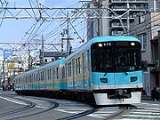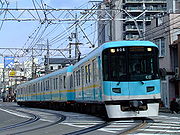
Keihan Keishin Line
Encyclopedia

Interurban
An interurban, also called a radial railway in parts of Canada, is a type of electric passenger railroad; in short a hybrid between tram and train. Interurbans enjoyed widespread popularity in the first three decades of the twentieth century in North America. Until the early 1920s, most roads were...
railway line of Keihan Electric Railway
Keihan Electric Railway
is a Japanese railway operator in Osaka, Kyoto, and Shiga Prefectures. It is known as , or .-History:Keihan started its operation between Osaka and Kyoto in 1910. It was the first electric railway to connect these two cities, and the first line on the left bank of Yodo River...
.
The 7.5 km line starts from Misasagi Station
Misasagi Station
is a train station in Yamashina-ku ward, city of Kyoto, Kyoto Prefecture, Japan.-Lines:* Kyoto Municipal Subway* Tōzai Line * Keihan Electric Railway* Keishin Line - Misasagi is the terminus of the line.-Layout:2nd basement...
in Kyoto
Kyoto
is a city in the central part of the island of Honshū, Japan. It has a population close to 1.5 million. Formerly the imperial capital of Japan, it is now the capital of Kyoto Prefecture, as well as a major part of the Osaka-Kobe-Kyoto metropolitan area.-History:...
and ends at Hamaōtsu Station
Hamaotsu Station
is a Keihan Railway train station in Ōtsu, Shiga Prefecture, Japan.Hamaōtsu Station is an interchange station of the Keihan Ōtsu Lines.- Layout :-Adjacent stations:-Past lines:...
in neighbouring city of Ōtsu
Otsu, Shiga
is the capital city of Shiga, Japan. The city was founded on October 1, 1898. As of October 1, 2010, the city has an estimated population of 338,629 with an average age of 40.7 years and a population density of 905.28 persons per km²...
.
History
The line was built in 1912 to connect directly between the city centers of Kyoto and Ōtsu by electricRailway electrification system
A railway electrification system supplies electrical energy to railway locomotives and multiple units as well as trams so that they can operate without having an on-board prime mover. There are several different electrification systems in use throughout the world...
streetcars
Tram
A tram is a passenger rail vehicle which runs on tracks along public urban streets and also sometimes on separate rights of way. It may also run between cities and/or towns , and/or partially grade separated even in the cities...
because the steam-powered
Steam locomotive
A steam locomotive is a railway locomotive that produces its power through a steam engine. These locomotives are fueled by burning some combustible material, usually coal, wood or oil, to produce steam in a boiler, which drives the steam engine...
Tōkaidō Main Line
Tokaido Main Line
The is the busiest trunk line of the Japan Railways Group , connecting Tōkyō and Kōbe stations. It is long, not counting its many freight feeder lines around the major cities...
made a great detour between the two cities before its reroute in 1921.
The busiest section of the line, between Keishin-Sanjō Station
Sanjo Station (Kyoto)
is the main Keihan Electric Railway station in Kyoto. It connects with Sanjo Keihan Station on the Kyoto Subway Tozai Line. It was opened for service on October 27, 1915, and has been in service ever since. Sanjo Station is located in the Higashiyama Ward, in Kyoto City...
and Misasagi Station, was replaced in 1997 by the Kyoto Subway Tōzai Line.
One of the aims of the substitution was to move the tracks underground, in order to give more lanes to road vehicles.
Consequently trains go direct to the Tōzai Line. The line still operates on street tracks in Ōtsu.
Technical data
- Distance: 7.5 km
- Gauge: 1435 mm
- Number of stations: 7 (including start and end)
- Track: Dual
- Electricity: DC 1500 V
- Maximum gradient: 61/1000
Train service
Except trains between Shinomiya Station and Hamaōtsu Station in early morning and late night, all trains go directly from Hamaōtsu Station to Kyoto Shiyakusho Mae Station or Uzumasa Tenjingawa StationUzumasa Tenjingawa Station
is a train station on the Kyoto Municipal Subway Tōzai Line, in Ukyō-ku ward, city of Kyoto, Kyoto Prefecture, Japan.-Lines:* Kyoto Municipal Subway* Tōzai Line...
on the Kyoto Subway Tōzai Line.
During off peak hours, the line operates four services an hour.
Active section
| Station | Connection | Location |
|---|---|---|
| Kyoto Subway Kyoto Municipal Subway is the metro network in the city of Kyoto, Japan. It is operated by Kyoto Municipal Transportation Bureau. It has two lines.-Lines:- External links :**... Tozai Line |
Yamashina-ku Yamashina-ku, Kyoto is one of the eleven wards in the city of Kyoto, in Kyoto Prefecture, Japan. It lies in the southeastern part of the city, and Yamashina Station is one stop away from Kyoto Station on the Tōkaidō Main Line .... , Kyoto Kyoto is a city in the central part of the island of Honshū, Japan. It has a population close to 1.5 million. Formerly the imperial capital of Japan, it is now the capital of Kyoto Prefecture, as well as a major part of the Osaka-Kobe-Kyoto metropolitan area.-History:... |
|
| JR West West Japan Railway Company , also referred to as , is one of the Japan Railways Group companies and operates in western Honshū. It has its headquarters in Kita-ku, Osaka.-History:... Tōkaidō Line Tokaido Main Line The is the busiest trunk line of the Japan Railways Group , connecting Tōkyō and Kōbe stations. It is long, not counting its many freight feeder lines around the major cities... (Biwako Line) and Kosei Line Kosei Line The is one of commuter rail lines and services in Osaka-Kobe-Kyoto Metropolitan Area, operated by West Japan Railway Company. The line was completed in 1974 by the former Japanese National Railways to provide faster access from the Kansai region to the Hokuriku region... Kyoto Subway Tozai Line |
||
| Ōtsu Otsu, Shiga is the capital city of Shiga, Japan. The city was founded on October 1, 1898. As of October 1, 2010, the city has an estimated population of 338,629 with an average age of 40.7 years and a population density of 905.28 persons per km²... , Shiga Shiga Prefecture is a prefecture of Japan, which forms part of the Kansai region on Honshu Island. The capital is the city of Ōtsu.- History :Shiga was known as Ōmi Province or Gōshū before the prefectural system was established... |
||
| Ishiyama Sakamoto Line |
Abandoned stations on the active section
- Midorigaoka Undōjō-mae: Shinomiya - Oiwake (extra station, abandoned in 1942)
- Kamisekidera: Ōtani - Kamisakaemachi (abandoned on August 15, 1971)
- Fudanotsuji: Kamisakaemachi - Hamaōtsu (abandoned on October 1, 1946)
Past connections
- Otani: JNRJapanese National Railways, abbreviated or "JNR", was the national railway network of Japan from 1949 to 1987.-History:The term Kokuyū Tetsudō "state-owned railway" originally referred to a network of railway lines operated by nationalized companies under the control of the Railway Institute following the nationalization...
Tokaido Line - Hamaotsu: Kōjak Railway
Abandoned section
The station list is as of 1997 when the section was abandoned due to replacement by the Tōzai Line subway. It also lists the corresponding subway stations that replaced the Keishin Line stations.| Station | Connection / note | Replaced by | Location |
|---|---|---|---|
| Keihan Main Line, Ōtō Line Keihan Oto Line The is a railway line in Kyoto that opened on October 5, 1989 as a branch of the Keihan Electric Railway. The Ōtō Line re-established a rail connection between the Keihan Main Line and the Eizan Electric Railway, which had been severed when the Kyoto City streetcars ceased running in 1978.The... |
Higashiyama-ku Higashiyama-ku, Kyoto ' is one of the eleven wards in the city of Kyoto, in Kyoto Prefecture, Japan. It was created in 1929 when it was split off from Shimogyō-ku. During the years 1931 to 1976 it also covered the area of present-day Yamashina-ku, which was an independent town until its merger into the city in 1931... , Kyoto Kyoto is a city in the central part of the island of Honshū, Japan. It has a population close to 1.5 million. Formerly the imperial capital of Japan, it is now the capital of Kyoto Prefecture, as well as a major part of the Osaka-Kobe-Kyoto metropolitan area.-History:... |
||
| Higashiyama-Sanjō | |||
| Abandoned in 1944 | |||
| Abandoned in 1931 | |||
| Keage | |||
| Kujōyama | Yamashina-ku, Kyoto |
||
| Hinooka | |||
| Misasagi |

